Grumman F-11 Tiger
| F11F/F-11 Tiger | |
|---|---|
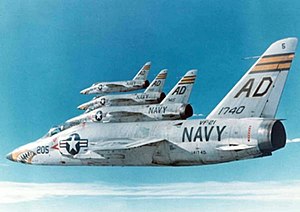
| |
| VF-21 F11F-1 Tigers in left echelon formation | |
| Role | Fighter aircraft |
| Manufacturer | Grumman |
| First flight | 30 July 1954 |
| Introduction | 1956 |
| Retired | 1961 (Carrier) 1967 (Training) 1969 (Blue Angels) |
| Primary user | United States Navy |
| Produced | 1954–1959 |
| Number built | 200 |
| Variants | Grumman F11F-1F Super Tiger |
The Grumman F11F/F-11 Tiger is a supersonic, single-seat carrier-based United States Navy fighter aircraft in operation during the 1950s and 1960s. Originally designated the F11F Tiger in April 1955 under the pre-1962 Navy designation system, it was redesignated as F-11 Tiger under the 1962 United States Tri-Service aircraft designation system.
The F11F/F-11 was used by the Blue Angels flight team from 1957–1969. Grumman Aircraft Corporation made 200 Tigers, with the last aircraft being delivered to the U.S. Navy on 23 January 1959.
Design and development[]

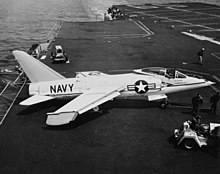

The F11F (F-11) Tiger origins can be traced back to a privately funded 1952 Grumman concept to modernize the F9F-6/7 Cougar by implementing the area rule and other advances. This Grumman company project was named G-98, and when it was concluded it was a complete design departure from the Cougar.
The design's potential for supersonic performance and reduced transonic drag stirred interest in the U.S. Navy. By 1953, redesigns led to a completely new aircraft bearing no more than a familial resemblance to the Cougar. The new wing had full-span leading edge slats and trailing edge flaps with roll control achieved using spoilers rather than traditional ailerons. For storage on aircraft carriers, the F-11 Tiger's wings manually folded downwards. Anticipating supersonic performance, the tailplane was all-moving. The aircraft was designed for the Wright J65 turbojet, a license-built version of the Armstrong Siddeley Sapphire.[1]
The U.S. Navy Bureau of Aeronautics was sufficiently impressed to order two prototypes, designated XF9F-8 even though the new fighter was clearly a new design. To add to the confusion, the prototypes were then redesignated XF9F-9 with the XF9F-8 designation going to another more straightforward Cougar derivative. Since the afterburning version of the J65 was not ready, the first prototype flew on 30 July 1954 with a non-afterburning engine. In spite of this, the aircraft nearly reached Mach 1 in its maiden flight. The second prototype, equipped with the afterburning engine, became the second supersonic U.S. Navy aircraft, the first being the Douglas F4D Skyray. In April 1955, the aircraft received the new designation F11F-1 (F-11A after adoption of the unified Tri-Service naming system in 1962). Carrier trials started on 4 April 1956 when an F11F-1 Tiger landed on and launched from USS Forrestal.[2]
The F-11 Tiger is noted for being the first jet aircraft to shoot itself down.[3] On 21 September 1956, during a test-firing of its 20 mm (0.79 in) cannons, pilot Tom Attridge fired two bursts midway through a shallow dive. As the trajectory of the cannon rounds decayed, they ultimately crossed paths with the Tiger as it continued its descent, disabling it and forcing Attridge to crash-land the aircraft; he survived.[4][5]
In addition to the F-11A (F11F-1) fighter, Grumman also proposed a more advanced version of the airframe known as the F11F-1F Super Tiger. This was the result of a 1955 study to fit the new General Electric J79 engine into the F11F-1 airframe.
Operational history[]
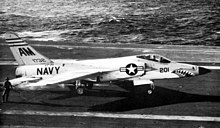

Seven U.S. Navy squadrons flew the F11F-1: VF-21 and VF-33 in the Atlantic Fleet and VA-156 (redesignated VF-111 in January 1959), VF-24 (redesignated VF-211 in March 1959), VF-51, VF-121, and VF-191 in the Pacific Fleet.[3]
In service, the Tiger operated from the carriers Intrepid, Lexington, Hancock, Bon Homme Richard, Shangri-La, Forrestal, Saratoga and Ranger. The F11F's career lasted only four years because its performance was inferior to the Vought F-8 Crusader and the J65 engine proved unreliable. Also, the range and endurance of the Tiger was found to be inadequate.[citation needed] Thus, the Navy cancelled all orders for the F11F-1P reconnaissance version and only 199 F11F-1 (F-11A) fighters were built.
The aircraft was withdrawn from carrier operations by 1961. It continued in service, however, in the Naval Air Training Command in south Texas at NAS Chase Field and NAS Kingsville, until the late 1960s. Students performed advanced jet training in the TF-9J Cougar, and upon completing that syllabus, were given a brief taste of supersonic capability with the F-11 before transitioning to fleet fighters.[6]
While the F-11's fighter career was short, the Blue Angels performed in the aircraft from 1957–1968, when the Tiger was replaced by the McDonnell Douglas F-4 Phantom II.[7]
Prior to the 1962 code unification, the fighter was known as the F11F; after unification, it was redesignated F-11.
In 1973, two former Blue Angels F-11As were taken from storage at Davis-Monthan AFB and modified by Grumman as testbeds to evaluate in-flight thrust control systems. BuNo 141853 was fitted with a Rohr Industries thrust reverser and BuNo 141824 was kept in standard configuration as a chase plane. Tests of the inflight thrust reversal were carried out by Grumman at Calverton beginning in March 1974 and continued at NATC Patuxent River, Maryland until 1975. Following the completion of these tests, both planes were returned to storage at Davis Monthan AFB. These were the last Tigers to fly.[8][9]
Variants[]

- YF9F-9
- Original designation.
- F11F-1
- Single-seat fighter version for the U.S. Navy, redesignated F-11A in 1962. 199 built and later production aircraft had a longer nose. One was used for static tests with a further production of 231 aircraft cancelled.
- F11F-1P
- Designation of a Navy photo reconnaissance version, 85 were cancelled.[6]
- F11F-1F Super Tiger (G-98J)
- F11F-1 fitted with the J79-GE-3A engine, two built.[10]
- F11F-1T
- Proposed tandem-seat trainer variant; unbuilt.[11]
Operators[]

 United States
United States
- United States Navy
Aircraft on display[]
- F11F-1

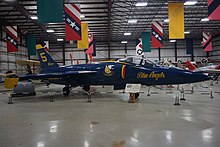
- 138619 - in Wilmington, North Carolina.
- 138645 – NAF El Centro in Imperial County, California.
- 141735 – Yanks Air Museum in Chino, California.[12]
- 141783 – MAPS Air Museum in Canton, Ohio.[13]
- 141790 – Grissom Air Museum at Grissom Air Reserve Base near Peru, Indiana.[14]
- 141802 – Lawson Creek Park in New Bern, North Carolina.[15]
- 141811 – Combat Air Museum in Topeka, Kansas.[16]
- 141824 – Pima Air & Space Museum in Tucson, Arizona.[17]
- 141828 – National Museum of Naval Aviation at Naval Air Station Pensacola, Florida.[18]
- 141832 – Cradle of Aviation Museum in Garden City, New York.[19]
- 141851 – NAES Lakehurst, New Jersey.[20]
- 141853 – Pueblo Weisbrod Aircraft Museum in Pueblo, Colorado.[21]
- 141859 – Veteran's Memorial Park in Tishomingo, Oklahoma.[22]
- 141864 – NAS Oceana Air Park, Virginia.[23]
- 141868 – Planes of Fame Air Museum in Valle, Arizona.[24]
- 141872 – Air Zoo in Kalamazoo, Michigan.[25]
- 141882 – Valiant Air Command Warbird Museum in Titusville, Florida.[26]
- 141869 – Discovery Park of America in Union City, Tennessee.
Specifications (F11F-1/F-11A)[]

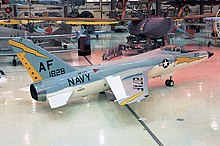
Data from United States Navy Aircraft since 1911[27] Standard Aircraft Characteristics: F-11A[28]
General characteristics
- Crew: 1
- Length: 45 ft 10.5 in (13.983 m)
- Wingspan: 31 ft 7.5 in (9.639 m)
- Width: 27 ft 4 in (8.33 m) wing-tips folded
- Height: 13 ft 2.75 in (4.0323 m)
- Wing area: 250 sq ft (23 m2)
- Empty weight: 13,810 lb (6,264 kg)
- Gross weight: 21,035 lb (9,541 kg)
- Max takeoff weight: 23,459 lb (10,641 kg)
- Powerplant: 1 × Wright J65-W-18 afterburning turbojet engine, 7,450 lbf (33.1 kN) thrust at 8,300 rpm, military power dry, 10,500 lbf (47 kN) with afterburner
Performance
- Maximum speed: 631 kn (726 mph, 1,169 km/h) / M1.1 at 35,000 ft (10,668 m)
- 654 kn (753 mph; 1,211 km/h) at sea level
- Cruise speed: 501 kn (577 mph, 928 km/h)
- Range: 1,110 nmi (1,280 mi, 2,060 km)
- Service ceiling: 49,000 ft (15,000 m)
- Rate of climb: 16,300 ft/min (83 m/s)
- Wing loading: 84 lb/sq ft (410 kg/m2)
- Thrust/weight: 0.5
Armament
- Guns: 4 × 20 mm (.79 in) Colt Mk 12 cannon, 125 rounds per gun
- Hardpoints: 4 with a capacity of –,with provisions to carry combinations of:
- Rockets: Aero 6A or Aero 7A "Rocket Package"
- Missiles: AIM-9 Sidewinder
- Other: 150 US gal (570 l) drop tank
Avionics
- AN/ARC-27A UHF COMMS
- AN/ARA-25 UHF
- AN/ARR-40 UHF
- AN/ARN-14E VHF Nav
- AN/APX-6B IFF
- AN/APA-89 video coder
- AN/APG-30A ranging radar
See also[]
Related development
Aircraft of comparable role, configuration, and era
- Douglas F5D Skylancer
- Supermarine Scimitar
- Vought F-8 Crusader
Related lists
- List of fighter aircraft
- List of military aircraft of the United States
References[]
Notes[]
- ^ "Naval Aircraft: Tiger." Naval Aviation News (U.S. Navy), September 1973, pp. 20–21.
- ^ Bowers 1990, p. 256.
- ^ Jump up to: a b Spick Air International June 1991, p. 318.
- ^ "A Tiger Bites Its Tail." Aerofiles. Retrieved: 1 April 2007.
- ^ "Unlucky First – The Shootdown of Tiger #620." Check-Six.com. Retrieved: 1 April 2007.
- ^ Jump up to: a b Baugher, Joe. "Grumman F11F-1/F-11A Tiger." Joe Baugher's Encyclopedia of American Military Aircraft, 30 January 2000. Retrieved: 26 July 2010.
- ^ "Historical Aircraft of the Blue Angels". Archived 2012-04-19 at the Wayback Machine Blue Angels. Retrieved: 30 August 2012.
- ^ http://www.angelfire.com/space/grumman/aircraft/tiger.html
- ^ http://www.joebaugher.com/navy_fighters/f11_1.html
- ^ Buttler pp. 114–115.
- ^ Bridgman, Leonard, ed. (1958). Jane's All the World's Aircraft 1958-59. London: Jane's All the World's Aircraft Publishing Co. Ltd. pp. 307–308.
- ^ "F11F Tiger/141735" Archived 2015-09-21 at the Wayback Machine Yanks Air Museum Retrieved: 15 January 2015.
- ^ "F11F Tiger/141783." Archived 2014-03-31 at the Wayback Machine MAPS Air Museum. Retrieved: 26 October 2012.
- ^ "F11F Tiger/141790" Grissom Air Museum. Retrieved: 15 January 2015.
- ^ "F11F Tiger/141802." Archived 2014-03-03 at the Wayback Machine Swiss Bear Downtown Development Corporation. Retrieved: 26 February 2014.
- ^ "F11F Tiger/141811." Combat Air Museum. Retrieved: 4 March 2013.
- ^ "F11F Tiger/141824." Pima Air & Space Museum. Retrieved: 15 January 2015.
- ^ "F11F Tiger/141828" National Museum of Naval Aviation Retrieved: 15 January 2015.
- ^ "F11F Tiger/141832." Archived 2015-01-05 at the Wayback Machine Cradle of Aviation Museum. Retrieved: 15 January 2015.
- ^ "F11F Tiger/141851." aerialvisuals.ca Retrieved: 26 October 2012.
- ^ "F11F Tiger/141853." Archived 2015-12-18 at the Wayback Machine Pueblo Weisbrod Aircraft Museum Retrieved: 15 January 2015.
- ^ "F11F Tiger/141859" aerialvisuals.ca Retrieved: 15 January 2015.
- ^ "F11F Tiger/141864." aerialvisuals.ca Retrieved: 26 October 2012.
- ^ "F11F Tiger/141868" Archived 2017-08-06 at the Wayback Machine Planes of Fame Air Museum Retrieved: 15 January 2015.
- ^ "F11F Tiger/141872." Air Zoo. Retrieved: 15 January 2015.
- ^ "F11F Tiger/141882." aerialvisuals.ca Retrieved: 8 April 2015.
- ^ Bowers 1990, p. 257.
- ^ NAVAIR 00-110AF11-1. Annapolis: Naval Air systems Command. 1 July 1967. Retrieved 9 April 2020.
Bibliography[]
- Andrade, John. U.S. Military Aircraft Designations and Serials since 1909. Hinckley, Leicestershire, UK: Midland Counties Publications, 1979. ISBN 0-904597-22-9.
- Bowers, Peter M. United States Navy Aircraft since 1911. Annapolis, Maryland: Naval Institute Press, 1990, pp. 183–185. ISBN 0-87021-792-5.
- Buttler, Tony. American Secret Projects: Fighters & Interceptors 1945–1978. Hinckley, Leicestershire, UK: Midland Publishing, 2008, First edition 2007. ISBN 978-1-85780-264-1.
- Crosby, Francis. Fighter Aircraft. London: Lorenz Books, 2002. ISBN 0-7548-0990-0.
- Gunston, Bill. Fighters of the Fifties. North Branch, Minnesota: Specialty Press, 1981. ISBN 0-933424-32-9.
- NAVAIR 00-110AF11-1: Standard Aircraft Characteristics, Navy Model F-11A Aircraft. Pax River, Maryland: Naval Air Systems, United States Navy Command.
- Spick, Mike. "The Iron Tigers". Air International, Vol. 40 No. 6, June 1991, pp. 313–320. ISSN 0306-5634.
- Thruelsen, Richard. The Grumman Story. Westport, Connecticut: Praeger Publishers, Inc., 1976. ISBN 0-275-54260-2.
External links[]
| Wikimedia Commons has media related to Grumman F11F Tiger. |
- Grumman aircraft
- 1950s United States fighter aircraft
- Single-engined jet aircraft
- Carrier-based aircraft
- Mid-wing aircraft
- Aircraft first flown in 1954
- Second-generation jet fighters